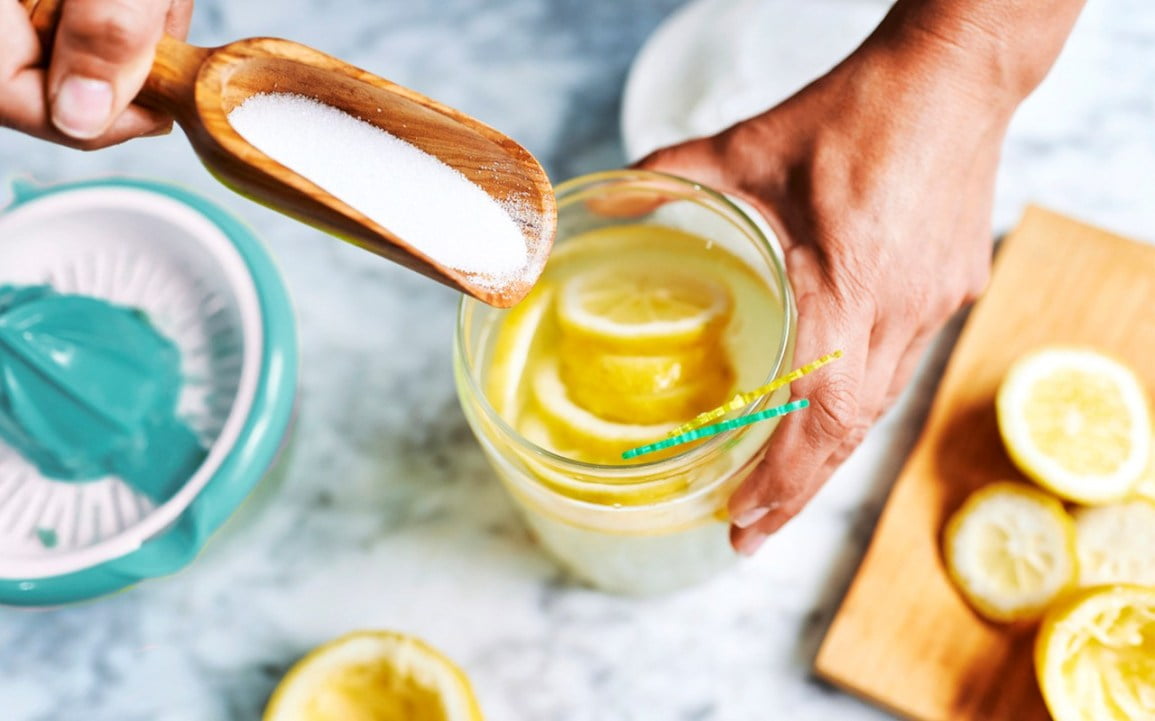Written by Franziska Spritzler, RD, CDE — Medically reviewed by Miho Hatanaka, RDN, L.D. —
Diabetes is a chronic disease that has reached epidemic proportions among adults and children worldwide (1Trusted Source).
Uncontrolled diabetes has many serious consequences, including heart disease, kidney disease, blindness, and other complications.
Prediabetes has also been linked to these conditions (2Trusted Source).
Importantly, eating certain foods can raise your blood sugar and insulin levels and promote inflammation, which may increase your risk of disease.
This article lists 11 foods and drinks that people with diabetes or prediabetes should avoid.

Carbs, protein, and fat are the macronutrients that provide your body with energy.
Among them, carbs have the greatest effect on your blood sugar by far. This is because they’re broken down into sugar, or glucose, and absorbed into your bloodstream.
Carbs include starches, sugar, and fiber. However, fiber isn’t digested and instead absorbed by your body in the same way other carbs are, so it doesn’t raise your blood sugar.
Subtracting fiber from the total carbs in a portion of food will give you its digestible or net carb content. For instance, if a cup of mixed vegetables contains 10 grams of carbs and 4 grams of fiber, its net carb count is 6 grams.
When people with diabetes consume too many carbs at a time, their blood sugar levels can rise to dangerously high levels.
Over time, high levels can damage your body’s nerves and blood vessels, which may set the stage for heart disease, kidney disease, and other serious health conditions.
Maintaining a low carb intake can help prevent blood sugar spikes and greatly reduce the risk of diabetes complications.
Therefore, it’s important to avoid the foods and drinks listed below.
1. Sugar-sweetened beverages
Sugary beverages are the worst drink choice for someone with diabetes.
First, they’re very high in carbs, with a 12-ounce (354-mL) can of cola providing 38.5 grams (3Trusted Source).
The same amount of sweetened iced tea and lemonade each contain almost 45 grams of carbs exclusively from sugar (4Trusted Source, 5Trusted Source).
In addition, these drinks are loaded with fructose, which is strongly linked to insulin resistance and diabetes. Indeed, studies suggest that consuming sugar-sweetened beverages may increase the risk of diabetes-related conditions like fatty liver disease (6Trusted Source, 7, 8).
What’s more, the high fructose levels in sugary drinks may lead to metabolic changes that promote belly fat and potentially harmful cholesterol and triglyceride levels.
In separate studies in adults with overweight and obesity, consuming 25% of calories from high fructose beverages on a weight-maintaining diet led to increased insulin resistance and belly fat, lower metabolic rate, and worse heart health markers (9Trusted Source, 10Trusted Source).
To help control blood sugar levels and prevent disease risk, consume water, club soda, or unsweetened iced tea instead of sugary beverages.
SUMMARYSodas and sweet drinks are high in carbs, which increase blood sugar. Also, their high fructose content has been linked to insulin resistance and an increased risk of obesity, fatty liver, and other diseases.
2. Trans fats
Artificial trans fats are extremely unhealthy.
They’re created by adding hydrogen to unsaturated fatty acids to make them more stable.
Trans fats are found in margarines, peanut butter, spreads, creamers, and frozen dinners. Furthermore, food manufacturers often add them to crackers, muffins, and other baked goods to help extend a product’s shelf life.
Although trans fats don’t directly raise blood sugar levels, they’ve been linked to increased inflammation, insulin resistance, and belly fat, as well as lower levels of HDL (good) cholesterol and impaired arterial function (11, 12, 13, 14, 15Trusted Source, 16Trusted Source).
While more research is needed to gain a clearer understanding of the relationship between trans fats and insulin resistance, the links mentioned above are especially concerning for people with diabetes, as they’re at an increased risk of heart disease.
Artificial trans fats have been outlawed in most countries, and in 2018 the Food and Drug Administration (FDA) banned the use of partially hydrogenated oil — the major source of artificial trans fat in the food supply — in most processed foods (17Trusted Source).
This doesn’t mean that all foods in the United States are now free of artificial trans fats. Manufacturers aren’t required to list trans fats on the nutrition facts labels if a product contains under 0.5 grams of trans fat per serving (18Trusted Source).
It’s best to avoid any product that contains the words “partially hydrogenated” in its ingredient list.
SUMMARYTrans fats are unsaturated fats that have been chemically altered to increase their stability. They’ve been linked to inflammation, insulin resistance, increased belly fat, and heart disease.
3. White bread, rice, and pasta
White bread, rice, and pasta are high carb, processed foods.
Eating bread, bagels, and other refined-flour foods has been shown to significantly increase blood sugar levels in people with type 1 and type 2 diabetes (19, 20).
This response isn’t exclusive to products made with refined white flour. In one study, gluten-free pastas were also shown to raise blood sugar, with rice-based types having the greatest effect (21Trusted Source).
Another study found that high carb foods not only raised blood sugar but also decreased brain function in people with type 2 diabetes and mental deficits (22).
These processed foods contain little fiber. Fiber helps slow the absorption of sugar into the bloodstream.
In other research, replacing these low fiber foods with high fiber foods was shown to significantly reduce blood sugar levels in people with diabetes. Moreover, people with diabetes experienced reductions in cholesterol.
Increased fiber consumption also improved gut microbiota, which may have led to improved insulin resistance (23Trusted Source).
SUMMARYWhite bread, pasta, and rice are high in carbs yet low in fiber. This combination can result in high blood sugar levels. Alternatively, choosing high-fiber, whole foods may help reduce blood sugar response.
4. Fruit-flavored yogurt
Plain yogurt can be a good option for people with diabetes. However, fruit-flavored varieties are a very different story.
Flavored yogurts are typically made from nonfat or low fat milk and loaded with carbs and sugar.
In fact, a 1-cup (245-gram) serving of fruit-flavored yogurt may contain almost 31 grams of sugar, meaning nearly 61% of its calories come from sugar (24Trusted Source).
Many people consider frozen yogurt to be a healthy alternative to ice cream. However, it can contain just as much or even more sugar than ice cream (25Trusted Source, 26Trusted Source).
Rather than choosing high sugar yogurts that can spike your blood sugar and insulin, opt for plain, whole milk yogurt that contains no sugar and may be beneficial for your appetite, weight control, and gut health (27, 28Trusted Source).
SUMMARYFruit-flavored yogurts are usually low in fat but high in sugar, which can lead to higher blood sugar and insulin levels. Plain, whole milk yogurt is a better choice for diabetes control and overall health.
5. Sweetened breakfast cereals
Eating cereal can be one of the worst ways to start your day if you have diabetes.
Despite the health claims on their boxes, most cereals are highly processed and contain far more carbs than many people realize.
In addition, they provide very little protein, a nutrient that can help you feel full and satisfied while keeping your blood sugar levels stable during the day (29Trusted Source).
Even some “healthy” breakfast cereals aren’t good choices for those with diabetes.
For instance, just a 1/2-cup serving (about 56 grams) of granola contains 44 grams of carbs, while Grape Nuts contain 47 grams. What’s more, each provides no more than 7 grams of protein per serving (30Trusted Source, 31Trusted Source).
To keep blood sugar and hunger under control, skip most cereals and choose a protein-based low carb breakfast instead.
SUMMARYMany breakfast cereals are high in carbs but low in protein. A high protein, low carb breakfast is the best option for diabetes and appetite control.
6. Flavored coffee drinks
Coffee has been linked to several health benefits, including a reduced risk of diabetes (32).
However, flavored coffee drinks should be viewed as a liquid dessert rather than a healthy beverage.
Studies have shown your brain doesn’t process liquid and solid foods similarly. When you drink calories, you don’t compensate by eating less later, potentially leading to weight gain (33Trusted Source, 34Trusted Source).
Flavored coffee drinks are also loaded with carbs.
For instance, a 16-ounce (473-mL) Caramel Frappuccino from Starbucks contains 57 grams of carbs, and the same size of the Blonde Vanilla Latte contains 30 grams of carbs (35, 36).
To keep your blood sugar under control and prevent weight gain, choose plain coffee or espresso with a tablespoon of heavy cream or half-and-half.
SUMMARYFlavored coffee drinks are very high in liquid carbs, which can raise blood sugar levels and fail to satisfy your hunger.
7. Honey, agave nectar, and maple syrup
People with diabetes often try to minimize their intake of white table sugar, as well as treats like candy, cookies, and pie.
However, other forms of sugar can also cause blood sugar spikes. These include brown sugar and “natural” sugars such as honey, agave nectar, and maple syrup.
Although these sweeteners aren’t highly processed, they contain at least as many carbs as white sugar. In fact, most contain even more.
Below are the carb counts of a 1-tablespoon serving of popular sweeteners:
- white sugar: 12.6 grams (37Trusted Source)
- honey: 17.3 grams (38Trusted Source)
- agave nectar: 16 grams (39Trusted Source)
- maple syrup: 13.4 grams (40Trusted Source)
In one study, people with prediabetes experienced similar increases in blood sugar, insulin, and inflammatory markers regardless of whether they consumed 1.7 ounces (50 grams) of white sugar or honey (41Trusted Source).
Your best strategy is to avoid all forms of sugar and use natural low carb sweeteners instead.
SUMMARYHoney, agave nectar, and maple syrup aren’t as processed as white table sugar, but they may have similar effects on blood sugar, insulin, and inflammatory markers.
8. Dried fruit
Fruit is a great source of several important vitamins and minerals, including vitamin C and potassium.
When fruit is dried, the process results in a loss of water that leads to even higher concentrations of these nutrients.
Unfortunately, its sugar content becomes more concentrated as well.
One cup (151 grams) of grapes contains 27.3 grams of carbs, including 1.4 grams of fiber. By contrast, 1 cup (145 grams) of raisins contains 115 grams of carbs, 5.4 of which come from fiber (42Trusted Source, 43Trusted Source).
Therefore, raisins contain more than four times as many carbs as grapes do. Other types of dried fruit are similarly higher in carbs than their fresh counterparts.
If you have diabetes, you don’t have to give up fruit altogether. Sticking to low sugar fruits, such as fresh berries or a small apple, can provide health benefits while keeping your blood sugar in the target range.
SUMMARYDried fruits become more concentrated in sugar and may contain more than four times as many carbs as fresh fruits do. Avoid dried fruit and choose fruits low in sugar for optimal blood sugar control.
9. Packaged snack foods
Pretzels, crackers, and other packaged foods aren’t good snack choices.
They’re typically made with refined flour and provide few nutrients, although they have plenty of fast-digesting carbs that can rapidly raise blood sugar.
Here are the carb counts for a 1-ounce (28-gram) serving of some popular snacks:
- saltine crackers: 20.7 grams of carbs, including 0.78 grams of fiber (44Trusted Source)
- pretzels: 22.5 grams of carbs, including 0.95 grams of fiber (45Trusted Source)
- graham crackers: 21.7 grams of carbs, including 0.95 grams of fiber (46Trusted Source)
In fact, some of these foods may contain even more carbs than stated on their nutrition label. One study found that snack foods provide 7.7% more carbs, on average, than the label states (47).
If you get hungry in between meals, it’s better to eat nuts or a few low carb vegetables with an ounce of cheese.
SUMMARYPackaged snacks are typically highly processed foods made from refined flour, which can quickly raise your blood sugar levels.
10. Fruit juice
Although fruit juice is often considered a healthy beverage, its effects on blood sugar are similar to those of sodas and other sugary drinks.
This goes for unsweetened 100% fruit juice, as well as types that contain added sugar. In some cases, fruit juice is even higher in sugar and carbs than soda.
For example, 8 ounces (250 mL) of soda and apple juice contain 22 and 24 grams of sugar, respectively. An equivalent serving of grape juice provides 35 grams of sugar (48Trusted Source, 49Trusted Source, 50Trusted Source).
Similarly to sugar-sweetened beverages, fruit juice is loaded with fructose. Fructose drives insulin resistance, obesity, and heart disease (51Trusted Source).
A much better alternative is to enjoy water with a wedge of lemon, which provides less than 1 gram of carbs and is virtually calorie-free (52Trusted Source).
SUMMARYFruit juices contain at least as much sugar as sodas. Their high fructose content can worsen insulin resistance, promote weight gain, and increase the risk of heart disease.
11. French fries
French fries are a food you may want to steer clear of, especially if you have diabetes.
Potatoes themselves are relatively high in carbs. One medium potato contains 34.8 grams of carbs, 2.4 of which come from fiber (53Trusted Source).
However, once they’ve been peeled and fried in vegetable oil, potatoes may do more than spike your blood sugar.
Deep-frying foods has been shown to produce high amounts of toxic compounds, such as advanced glycation end products (AGEs) and aldehydes. These compounds may promote inflammation and increase the risk of disease (54Trusted Source, 55Trusted Source).
Indeed, several studies have linked frequently consuming french fries and other fried foods to heart disease and cancer (56Trusted Source, 57Trusted Source, 58Trusted Source, 59Trusted Source).
If you don’t want to avoid potatoes altogether, eating a small serving of sweet potatoes is your best option.
SUMMARYIn addition to being high in carbs that raise blood sugar levels, french fries are fried in unhealthy oils that may promote inflammation and increase the risk of heart disease and cancer.
The bottom line
Knowing which foods to avoid when you have diabetes can sometimes seem tough. However, following a few guidelines can make it easier.
Your main goals should include staying away from unhealthy fats, liquid sugars, processed grains, and other foods that contain refined carbs.
Avoiding foods that increase your blood sugar levels and drive insulin resistance can help keep you healthy and reduce your risk of future diabetes complications.
It might likewise help to reach out to others for support. Healthline’s free app, T2D Healthline, connects you with people living with type 2 diabetes. Ask diet-related questions and seek advice from others who get it. Download the app for iPhone or Android.
Source: https://www.healthline.com
Disclaimer: We at Prepare for Change (PFC) bring you information that is not offered by the mainstream news, and therefore may seem controversial. The opinions, views, statements, and/or information we present are not necessarily promoted, endorsed, espoused, or agreed to by Prepare for Change, its leadership Council, members, those who work with PFC, or those who read its content. However, they are hopefully provocative. Please use discernment! Use logical thinking, your own intuition and your own connection with Source, Spirit and Natural Laws to help you determine what is true and what is not. By sharing information and seeding dialogue, it is our goal to raise consciousness and awareness of higher truths to free us from enslavement of the matrix in this material realm.
 EN
EN FR
FR


























Thanks for giving this helpful and knowledge able information.
This information helps diabetes patient to avoid some food.
Very nice article.
Thanx for sharing your knowledge once again. Feel free to visit ketodietcenter.in